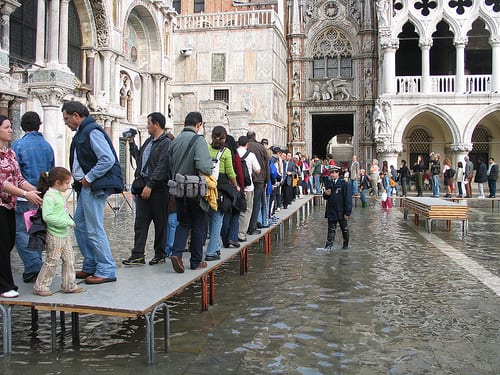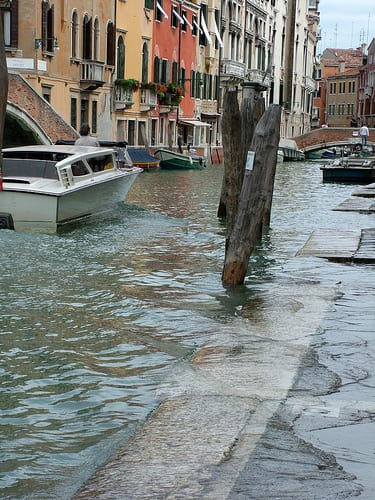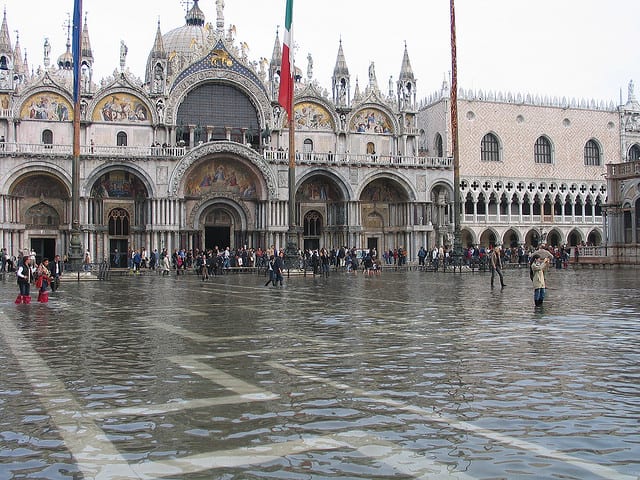Venice’s Acqua Alta: How to Deal With
The acqua alta of Venice recently reached such heights (…or depths), it was all over the news. More than 70 percent of Venice was under water. Last weekend, in fact, the acqua alta got up to 149 cm (4 ft 10 inches), the 5th-highest level the floods have reached in the past 150 years. (See some extraordinary photos of the acqua alta here!).
The pictures are stunning: People swimming through St. Mark’s Square, merchandise floating in shops, locals paddling to work. But what is it really like to visit—or live in—Venice when there’s acqua alta? Here’s a survival guide!
What is acqua alta?

Woman walking in Venice’s acqua
Acqua alta literally means “high water”—and that’s what it is! Because of Venice’s unique position as an island criss-crossed with canals, the city is, of course, very sensitive to water levels. So whenever water levels rise in the Venetian lagoon… the island of Venice is at an increased chance of flooding.
Acqua alta usually happens in the winter, thanks to a combination of the tides, a strong south wind, and the periodic movement of sea waters. But it’s been happening more often—and been getting worse—in recent decades, thanks to Venice’s sensitivity to climate change.
Earlier this year, in fact, it was discovered that the island was sinking five times faster than previously thought, at a rate of 2 millimeters per year. While that might not sound like much, it adds up: The Rialto Bridge, for example, has sunk 1.7 meters (5 feet) since it was first built!
Venice is sinking partly because, thanks to climate change and the melting of the glaciers, water levels are rising worldwide at a rate of 0.14 inches per year. And it’s partly because of issues particular to Venice itself, like the industrialization of adjacent Mastre-Marghera and the increase of pumping water and natural gas from the ground.
How often does acqua alta occur?
Statistically, exceptional high tides—when the water level of the lagoon is 140 cm or more above the standard sea level, the point at which more than half of the island of Venice is flooded—only happen once every four years. But more minor flooding occurs much more often: Water reaching 110 cm, at which point flooding covers 14 percent of Venice, happens about four times a year.In general, if you’re coming during the winter, particularly November or December, be prepared for the possibility of acqua alta!
Here’s a good video tour of what to expect when it gets really bad:
How long does acqua alta last?
It generally lasts for only a few hours—but not always! It depends on the neighborhood and how hard it was hit.How do I know when acqua alta is going to hit Venice?
Those who live in Venice are notified by the city by phone or SMS. But if acqua alta is estimated to be particularly bad, everyone gets notified, thanks to a system of sirens that sound throughout the island! Keep your ears open for any whistles… the more there are, the worse it’s going to be. You can also check online at Venice’s acqua alta forecast website.And, of course, you can always ask your hotel what the likelihood is that acqua alta is coming—you can bet that they’ll know!
How do I get around when Venice is flooded?

You’ll probably get a little wet regardless–the passarelle don’t always connect at every point—but it’ll keep you out of the worst of it.
Do I pack my rain boots?
Not necessarily! Again, remember that, even in the terrible flooding
there was last week, almost half of the island was still dry. So many
people prefer to wait out the acqua alta at their hotel or in a
drier part of town.
Otherwise, of course, rain boots can come in handy…
but they do take up lots of suitcase space, so you might consider
buying them when you get to Venice instead, if you discover they’re
necessary. Some hotels are even kind enough to loan rubber boots to
guests.
Forget staying dry—this seems like a fun opportunity to swim in St. Mark’s Square and take some great photos! Is it?
No. And it could be unsafe. First of all, remember that the water is
going to be very cold. Secondly, it’s very dirty—something you’ll
probably notice as soon as you see it, since it often comes with garbage
and other debris floating (remember, this is water that’s swept through
not only Venice’s piazzas, but its garbage cans, stores, and more!).
Full of bacteria, it’s probably not something you want to submerge your
body in! And
no, the smell often isn’t great.
Be safe, and don’t go barefoot in the flooded areas (or anywhere else, for that matter!).
What happens to transportation and sights?
In many ways, Venice trundles on as usual during acqua alta. But some things are hindered. Boats run, but might have to change their routes, because they may not be able to pass under some bridges. And some stores, restaurants, and sights might be forced to close temporarily.What does acqua alta mean for how much I should pack?
Strange question? Not really! Many people don’t think about what they’ll do if they get to their hotel… and the walk there is flooded. The option to wheel your suitcase vanishes—unless you want to get it soaked. So you need to be strong enough to carry it above your head. Something to keep in mind if you’re visitingVenice in the high-risk months!
 |
| During acqua alta, it’s not always that easy to tell where land stops and the canal begins! |
Any other tips?
Yes—be careful if you’re walking on flooded sidewalks next to canals!
Because of the flooding, it’s often harder to see the edge between the
land and the canal. Watch your step if you want to avoid getting really soaked!


No comments:
Post a Comment